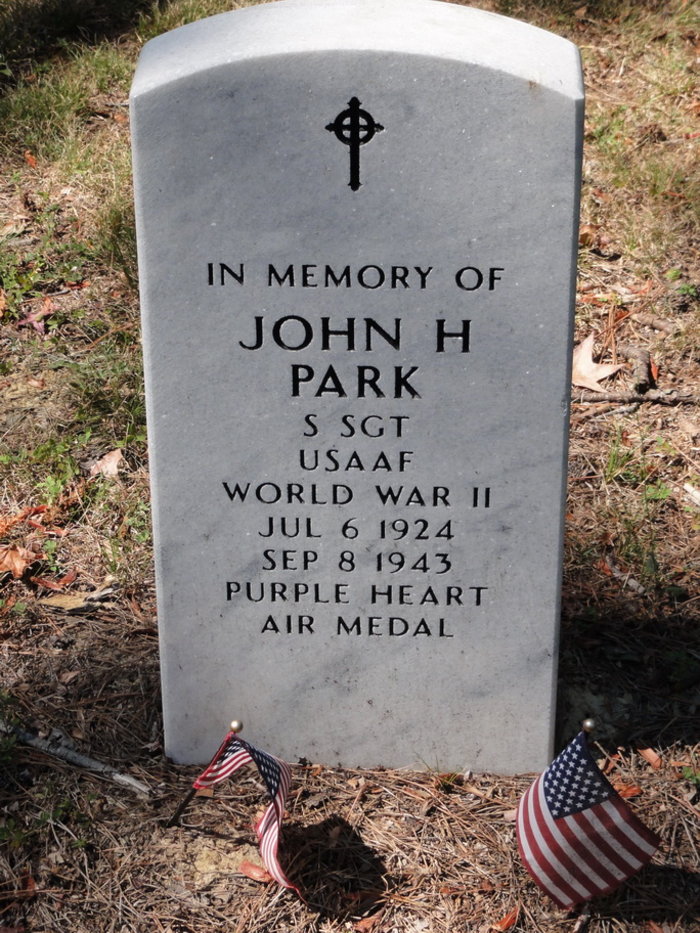John H. Park was born on July 6, 1924. He served in the 552nd Bomber Squadron, 386th Bomber Group, Medium as a Staff Sergeant during World War II. He died on September 8, 1943 and is now buried in the Willis United Methodist Church Cemetery, Richmond, Henrico County, Virginia, USA.
From https://b26.com:
September 8, 1943 - 386th Bomb Group Mission Number 17.
Target: Airdrome located at Lille-Vendeville, France.
The axis of attack was from west to east on a 190 m.p.h. bomb run as Lieutenant Romney J. Spencer flying "MARGIE" 134970 RG-L received a flak in the right engine. That engine smoking badly lost power and ceased to run. The 552nd pilot trimmed the ship, feathered the propeller on the dead engine and continued on the bomb run. In order to maintain speed he had to nose down a bit and dropped his bomb load with the rest of the formation as the dispersal area of the target aiming point came into view. Immediately after the bomb run his ship fell behind and below the formation. Four Spitfires from our escort dropped down around him to provide cover, as viewed by the author. My crew was flying in a ship named "SLIGHTLY DANGEROUS" 134941 RG-D. We were flying in number five position off the right wing of Lieutenant Spencerís aircraft.
Some thirty miles from the target on the way out, two FW-190ís turned in toward the stricken bomber, but were only able to get off a short burst of 20mm cannon fire. Luckily Spencer was able to guide his plane into a nearby cloud bank, as the Spitfires dispatched one the enemy fighter planes. Altitude was continually lost as he broke clear of the cloud cover at 4,000 feet. Light flak came up near the enemy coast in the vicinity of Gravelines, as his left engine began to malfunction!
Working the throttle and primer he managed to get the engine up to power. A few short minutes later it stopped, and the crew prepared for ditching! The pilot worked the throttle and primer frantically, an air speed of just over 130 m.p.h., precious altitude was slipping away. Suddenly the left engine of "MARGIE" responded with a roar only fifty feet above the water. They tried to gain altitude while crossing the channel, but to no avail.
The White Cliffs Of Dover loomed directly ahead, now a runaway propeller added to their difficulty with the air speed at a bare minimum. About five miles off the coast of England it became apparent the ship must be landed in the water. Staff Sergeant Harold Hadley had already sent out a distress call and then tied down the key of his radio trans-mitter to allow a station to get a fix on their position.
The crew gathered in the radio-navigatorís compartment and opened the navigatorís hatch in the top of the plane; then they assumed ditching positions The co-pilot de-creased engine r.p.m. to 1500 as the pilot took the elevator trim out, the co-pilot hit the feather switchóas it took action the trim was completely in neutral position. No flaps were used. Flight Officer Glenn Johnson unlocked the pilot and co-pilot roof escape hatches. Air speed was 110 m.p.h.; the tail cone touching the water as the pilot held the ship off a few more seconds. The aft section of the fuselage was plowing water; at that point Flight Engineer John Park apparently thought that they were completely settled into the channelóhe raised up to look into the cockpit just as the engine nacelles caught huge gulps of water. There was a violent elastic stop; and the plane pitched nose down-ward approximately forty-five degrees.
Staff Sergeant Park was hurled forward striking the pilotís pedestal; Co-pilot Johnson made a grab for him, but the force was too great for him to hold onto Parkís body as it bounced over Johnsonís legs and down into the nose compartment. The ship had now assumed a ninety degree nose down attitude and sank very rapidly, it was completely under water in fifteen seconds!
The crew members had inflated their Mae Wests and floated to the surface. The first man up said he saw the rear tip of the rudder go under and the ship was gone! Pilot Romney Spencer, Co-pilot Glenn Johnson, Bombardier J.H. Bowen, Radioman Harold Hadley, and Tail Gunner Aubrey Ruess bobbed on the surface in the light swells. Hadley and Ruess received injuries in the water landing. The Spitfires that had stayed with them circled overhead as one Spitfire came in low and dropped a rubber dinghy nearby. As they looked at each other, a sad realization came over them, for they knew their crew mate John Park had gone down with the plane and was lost! After some thirty minutes an Air-Sea-Rescue boat picked them up, and in a few hours they returned to base at Boxted.
Meanwhile interrogation of the returning crews was underway, most reported seeing Lieutenant Spencerís aircraft firing red distress flares when he was hit on the bomb run. Others reported the FW-190 attack on his plane, and the fact that a Spitfire had shot the enemy down. Eight RAF Squadrons of Spitfires had defended the seventy-two ship formation made up of the 322nd and 386th B-26 Bomb Groups. There were four RAF Squadrons of close cover, two squadrons of high cover, and two squadrons of top cover. Nothing but praise could be heard for the Spitfire pilots who had flown excellent bomber cover on this mission.

PRIVATE CITIZENS SUPPORTING AMERICA'S HERITAGE
American
War Memorials Overseas, Inc.
War Memorials Overseas, Inc.
Park John H.
Name:
John H. Park
Rank:
Staff Sergeant
Serial Number:
Unit:
552nd Bomber Squadron, 386th Bomber Group, Medium
Date of Death:
1943-09-08
State:
Virginia
Cemetery:
Willis United Methodist Church Cemetery, VA
Plot:
Row:
Grave:
Decoration:
Air Medal, Purple Heart
Comments:
